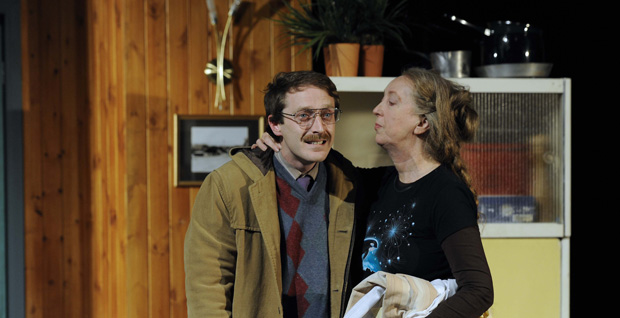Showing @ Traverse Theatre, Edinburgh until Sat 17 Nov
As heavy emphasis is placed on metropolitan life, both on London to address the economy and ourselves as we’re pampered by a swathing culture of technology, there is a growing need to relocate to conversations on community. Beautifully skewed is this idea in Morna Pearson’s new play, directed by Orla O’Loughlin: a journey into the unusual mother/son relationship of Edie (Anne Lacey) and thirtysomething Geoffrey (Garry Collins).
In order to escape the banality of routine, and the anxiety of his life as a tortured art teacher, Geoffrey regresses into his shed to paint. More importantly, he seeks a life outside the four walls that he shares a little too closely with his mother. After chatting with astute ex-student Evelyn (Lynn Kennedy), he puts up an ad on the local notice board. Clara is one of his replies, a worrisome loner played by the indefatigable Molly Innes, and soon, Geoffrey begins to realise what he’s been missing all these years.
It would be easy to run towards the strong oedipal tone consistent in Pearson’s play as a point of major critical analysis. More interesting are the cultural specifics and linguistic impressions made by the play’s characters, both of which come under threat from external forces. The Doric dialect is diluted with hints of Standard English and the cosseted, micro-town life still finds itself invaded by Sainsbury’s and Lidl. The deadening rituals of Geoffrey and his mother (think darker versions of Seymour and Agnes Skinner) produce dangerously pressurised dynamics, choking the social and sexual freedoms which allow us to express, explore and expand our personalities. Geoffrey’s liberation comes from Clara as the couple go to raves and indulge in bizarre games of arousal; it’s this relationship which confronts Edie most directly.
The balance of themes also makes for uneasy yet contemplative viewing. Evidence of Geoffrey’s umbilical connection to his mother is often unsettling, but Pearson’s language is rhythmic and easy on the ear, generating an inviting and almost restful quality which clashes against the disturbing nature of the play. In this sense, we are the greatest of voyeurs, digesting the behaviour of Pearson’s characters rather than judging it. And it is equally as rewarding to see Pearson in fine form here as it is to venture into the hidden disposition of irregular families; she challenges taboos without pushing them over the edge and isn’t troubled by unearthing the level of dysfunction that can materialise from extreme intimacy. It is subtly profound and intricate playwriting, blessed with confident, fresh direction which complements the wealth of ideas on offer.
